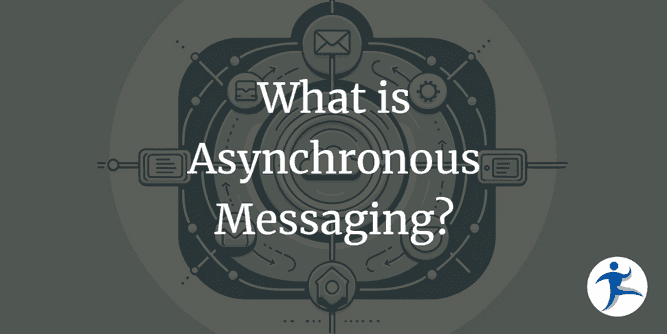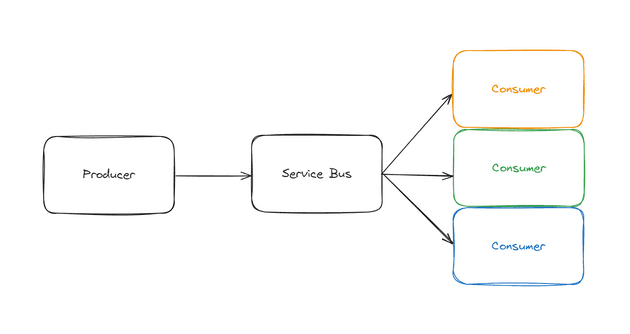In today’s increasingly complex world of software development, asynchronous messaging has become a fundamental architectural principle when building service-oriented, event-driven, and highly distributed systems. Asynchronous messaging refers to a communication method where messages can be sent and received independently of each other. This enables the sender to continue with other tasks without waiting for a response from the receiver. Asynchronous messaging allows for the decoupling of components and services, freeing them to be deployed and orchestrated independently. This can improve scalability, performance, and fault tolerance in many scenarios. Common examples of asynchronous messaging include message queues, publish-subscribe systems, and event-driven architectures.
It’s worth noting that the topic of asynchronous messaging is vast and complex with a wide range of terminology and patterns. Many architectures, patterns, and frameworks can be used to implement systems utilizing this principle often with overlap in features between frameworks and platforms. In this article, we’ll provide a high-level overview of the concepts and patterns of asynchronous messaging, as well as some of the benefits and frameworks available in the .NET ecosystem. This is by no means a comprehensive guide, but it should provide a good starting point for understanding the fundamentals of asynchronous messaging.
Asynchronous Messaging Patterns and Concepts
There are several common patterns and techniques for implementing asynchronous messaging in distributed systems. Some of the most widely used patterns include:
- Message Queues: In a message queue, messages are sent to a queue and then retrieved by one or more consumers. This pattern is often used to decouple producers and consumers, allowing the sender to continue processing messages without waiting for the receiver to respond. Senders can wait for a response but this is usually implemented in the form of a callback to the sender from the receiver rather than synchronously waiting. Message queues can be used to implement reliable messaging, load leveling, and fault tolerance in distributed systems. The following image shows a simple workflow with a single producer sending a message to a queue, which is then consumed by a single consumer.
- Publish-Subscribe: In a publish-subscribe system, messages are published to one or more topics, and then received by one or more subscribers. This pattern is often used to implement event-driven architectures, where components can react to events and notifications without needing to know the details of the other components. Publish-subscribe systems can be used to implement real-time messaging, event sourcing, and data distribution in distributed systems. The following image shows a simple workflow with a single producer sending a message to a service bus, which is then consumed by multiple consumers.
-
Message Brokers: A message broker can be thought of as messaging middleware, similar to that in ASP.NET Core’s request pipeline, that acts as an intermediary between producers and consumers in a messaging pipeline. Message brokers can provide a range of features, such as message routing, filtering, transformation, and delivery guarantees. Message brokers can be used to implement complex messaging scenarios, such as message aggregation, content-based routing, and message enrichment in distributed systems. An example of a message broker is Azure Service Bus which is a fully managed enterprise-grade message broker.
-
Event Sourcing: In Event Sourcing, the state of a system is derived from a sequence of events. Events are stored in an event log and can be replayed to reconstruct the state of the system at any point in time. Event sourcing can be used to implement audit trails, temporal queries, and consistency in distributed systems. It is often associated with techniques from the Command-Query Responsibility Segregation (CQRS) pattern to separate the read and write models of a system.
Benefits of Asynchronous Messaging
Asynchronous messaging offers many benefits in distributed systems. The following are just a few of the key advantages:
-
Decoupling: Asynchronous messaging allows components to communicate without needing to know the details of the other components. This reduces dependencies and makes it easier to change and evolve the system over time. in many cases, a receiver may not need to be online at the same time as a sender, be located on the same machine, or even be built using the same technology stack. This decoupling simplifies system architecture and enhances flexibility in development, deployment, and maintenance.
-
Scalability: Asynchronous messaging can help improve system scalability by allowing components to process messages at their own pace. This can be especially useful in scenarios where the volume of messages fluctuates or where processing times vary. By decoupling the sender and receiver, asynchronous messaging can help distribute the load across multiple instances of the receiver, allowing the system to handle higher throughput and larger workloads.
-
Improved Responsiveness and User Experience: Asynchronous messaging can improve system performance by allowing components to process messages concurrently. This can help reduce latency and improve overall system responsiveness. For example, in a web application, asynchronous messaging can be used to offload long-running tasks, such as sending emails or integrating with third-party APIs, allowing the user to continue interacting with the application without waiting for these tasks to be completed. This often has tradeoffs between ACID (atomicity, consistency, isolation, durability) and Eventual Consistency but can be a powerful tool for improving user experience.
-
Reliability and Fault Tolerance: Asynchronous messaging can help improve system reliability and fault tolerance by providing a buffer between the sender and receiver. If the receiver is temporarily unavailable or unable to process messages, the sender can continue to send messages to a queue or topic, knowing that they will be processed when the receiver becomes available. This can help prevent message loss and improve system resilience when failures do occur.
Frameworks and Technologies for Asynchronous Messaging in .NET
Several frameworks in the .NET ecosystem can be used to implement asynchronous messaging. Some of the most popular include:
-
RabbitMQ: RabbitMQ is an open-source message broker software that implements the Advanced Message Queuing Protocol (AMQP). RabbitMQ can be used to implement messaging, event-driven architectures, and distributed transactions in distributed systems. Its features support point-to-point, publish/subscribe, and request/response messaging patterns. RabbitMQ has a .NET client library that can be used to build applications that send and receive messages using RabbitMQ as the underlying messaging infrastructure.
-
NServiceBus: NServiceBus is a messaging framework for .NET that provides support for message queues, publish-subscribe, and message brokers. It is the foundation of the Particular Service Platform that includes tools for messaging and workflow creation, advanced debugging, and production monitoring. NServiceBus also supports long-running asynchronous processes via Sagas which can implement the Saga Pattern for orchestrating complex workflows. NServiceBus shines when reliable messaging, distributed transactions, and workflow orchestration are required. It is also supported by a large community and has a ton of content available for learning not only the framework but also the patterns and practices it supports.
-
MassTransit: MassTransit is a distributed application framework for .NET that provides support for message queues, publish-subscribe, and message brokers. It provides a developer-focused, modern platform for creating distributed applications without complexity. If you’re interested in MassTransit, you might also want to check out this article by Ardalis on getting started: Introduction to MassTransit; A Guide to Streamlined Messaging in C#.
Both NServiceBus and MassTransit are built on top of the .NET ecosystem and aren’t locked into a specific messaging technology. They provide a high-level abstraction over the underlying messaging infrastructure, allowing them to be deployed with a variety of services like RabbitMQ, SQL Server, and Azure Service Bus.
- Azure Service Bus: Azure Service Bus is a cloud-based messaging service that provides support for message queues, publish-subscribe, and message brokers. Azure Service Bus can be used to implement reliable messaging, event-driven architectures, and distributed transactions in cloud-based distributed systems. Azure Service Bus has its own SDK for building applications that implement one-way sending and publish-subscribe messaging. It can also be used as a backend for other messaging frameworks like NServiceBus and MassTransit.
Conclusion
Asynchronous messaging is a fundamental architectural principle in modern distributed systems. It offers many benefits, such as decoupling, scalability, improved responsiveness, and reliability. There are several common patterns and techniques for implementing asynchronous messaging, such as message queues, publish-subscribe, message brokers, and event sourcing. In the .NET ecosystem, several frameworks and libraries can be used to implement asynchronous messaging, such as NServiceBus, MassTransit, Azure Service Bus, and RabbitMQ. By leveraging these patterns and frameworks, developers can build highly scalable, responsive, and reliable distributed systems that can meet the demands of today’s complex architectural ecosystems.




